Sky City aims high on many levels
Updated: 2013-08-14 10:51
By Zhang Yuwei in New York (China Daily)
|
||||||||
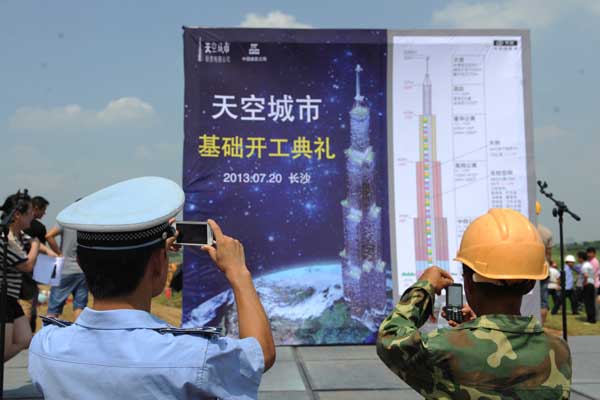 |
|
People take photo of the artist's rendering of would-be world's tallest building 'Sky City' in Changsha, capital city of central China's Hunan province.[China Daily] |
Dubai's 828-meter-high Burj Khalifa skyscraper's title of the world's tallest building will be history next year when Broad Group's Sky City is completed.
The 202-story Sky City will go up in Changsha in central China's Hunan province. Once completed, it will top off at 838 meters, 10 meters higher than Burj Khalifa.
Sky City's construction cost is estimated at $1.47 billion compared to the Burj Khalifa's $1.5 billion. But the big difference between the two buildings is that the Dubai tower took five years to build and Sky City will take seven months.
Changsha-based Broad Group, whose core business has been the manufacture of industrial heating, ventilation and air-conditioning systems, had its groundbreaking ceremony on July 20 for the future world's tallest building.
The actual construction won't start until next April, according to Wang Shuguang, general manager of Broad Group's US operation, which is based in New Jersey.
The ambitious plan has drawn skepticism from experts at home and abroad, questioning its approach of using sustainable prefabricated construction materials developed from the company's core business.
The building is supposed to go up so quickly because construction workers will only be required to assemble prefab building materials which have been made in a factory.
Wang said the project will potentially hire some 3,000 construction workers on site.
During a radio interview, Lu Meng, a Chinese architect, cautioned that too much emphasis on speed means sacrificing "quality". Other critics have called the tower - which will house some 30,000 people with schools, shops, cinemas and basketball courts - a "destruction of cities".
But Zhang Yue, founder of Broad Group, believes that Sky City contributes to solving some of urban planning's toughest issues, especially heavy traffic.
"The Sky City is designed to reduce the city's dependence on roads and vehicles and thus reduce traffic jams," said Zhang, a 53-year-old former artist who founded the company in 1988 with about $3,000. "It is a revolution of the 'zoned community'."
Some also call Sky City a "destruction of the ecosystem", a criticism that Zhang dismisses as "missing logic".
"When you build tall, land can be more efficiently used, thus saving more land for trees and fields, which is surely more eco-friendly than low-rise and sprawling cities," he said.
Still others think the project is a breakthrough on many levels.
"This unconventional but innovative project may provide some unique resolutions for the global triple crises of climate change, global employment and social inequity," said C. S. Kiang, Chairman of Sustainable Development Technology Foundation.
Kiang said although the project will have a global following once it's complete, it will still need continuous support from experts and residents.
Michael Tilford, president of Alumni Association MIT Center for Real Estate, is one of those who regard the project highly.
"It is unconventional in its speed and size of course," said Tilford. "It is very exciting that Broad Group took the time to examine the construction process so carefully and challenge all of the conventions of building skyscrapers," he added.
"I can guess that many people are simply afraid of change," Tilford said.
"The world's tallest buildings are usually designed, approved and built over the span of many years," he explained. "As with all things there are pros and cons to the traditional process. Broad has found a way to build buildings in a matter of months and sometimes weeks, which is shocking to some people."
The company completed the T30 hotel tower in Changsha last year in 15 days.
"All construction was complete, including interior furnishings, heating-cooling and ventilation systems; everything was ready," said Wang, adding that the company's HVAC expertise also helped cut construction time.
"You have seen our 30-story building built in two weeks, and that applies to [Sky City] as well," said Zhang at the 2013 London conference of the Council of Tall Buildings and Urban Habitat in June.
"This building, as compared to a conventional building in the local area, can decrease energy consumption by 50 percent. We are building this 202-story building, [and] our main hope is to draw people's attention to the fact that within a building, there is such a big opportunity for energy consumption savings," Zhang said.
Wang said the company's US operation currently works on some 50 projects across the country with several hundred customers who are on its gas-or waste fuel-powered AC systems. He hopes their US business will expand with successful projects - like Sky City - completed at home.
The Sky City project, said Wang, will be anything but a "fantasy".
"The whole project showcases our expertise in innovation and energy-savings, it is not a project just to make profit, it is something that we want to do to contribute to society for urban planning," said Wang.
"I am not surprised that the tallest building in the world has drawn this amount of criticism and skepticism," said Kiang.
Ongoing criticisms of the project - regarding building timetable, construction methods and financing - Kiang said can be explained with an old Chinese saying: "The large tree will attract a big wind".
yuweizhang@chinadailyusa.com
(China Daily USA 08/14/2013 page1)
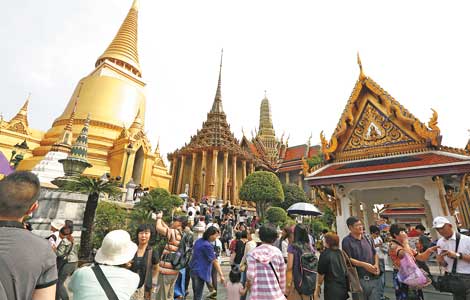
 When small is beautiful in hotel industry
When small is beautiful in hotel industry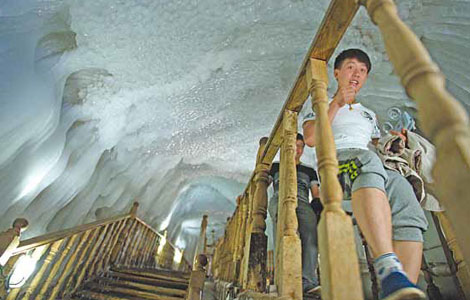
 Northern exposure
Northern exposure
 Re-enacting ancestors' journey to the west
Re-enacting ancestors' journey to the west
 Special bus seat for breast-feeding mothers
Special bus seat for breast-feeding mothers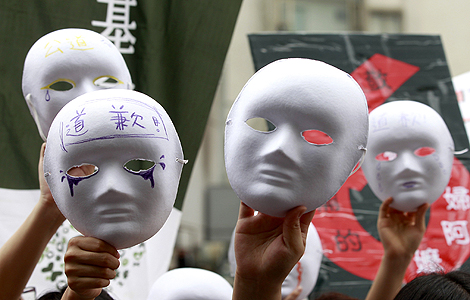
 Protests arise in Taiwan over 'comfort women'
Protests arise in Taiwan over 'comfort women'
 Huawei unveil Ascend P6 smartphone in Vienna
Huawei unveil Ascend P6 smartphone in Vienna
 That's one cool game of mahjong
That's one cool game of mahjong
 Isinbaeva leads harvest day for host Russia
Isinbaeva leads harvest day for host Russia
Most Viewed
Editor's Picks

|
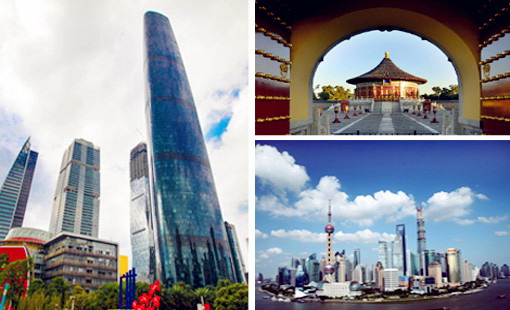
|
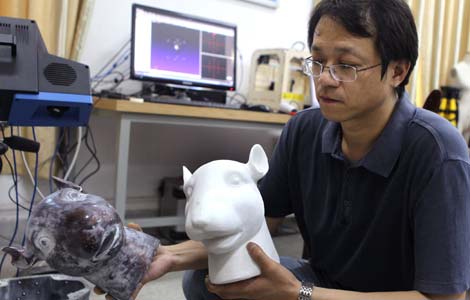
|

|
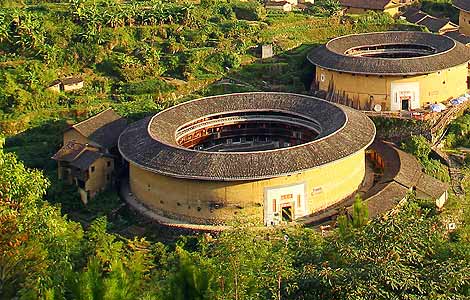
|

|
Today's Top News
Guangdong battered as typhoon makes landfall
Watchdog to protect rights of consumers
Egypt declares monthlong state of emergency
Sizzling summer tops the record list
UN seek private firms' help in curbing HIV/AIDS
China to probe foreign automakers
Yao Ming's towering charity
Fingerprint ID cards to prevent fraud
US Weekly

|

|




